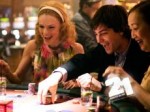Blackjack attack

Sony Pictures’ 21 promises to be a decent film showcasing the brilliance and ingenuity of Massachusetts Institute of Technology (MIT) math students and their winning streak at several Las Vegas casinos. Headlined by Kevin Spacey, who plays one of several masterminds with the ambition of winning big, the film takes true events – which also inspired the book Bringing Down the House – from 1993 and adds flair and excitement to make a welcome addition to the crime-heist genre. Much to the chagrin of the actual people involved, however, Hollywood took an O.C.-inspired approach to the casting.
The the true story of the six ingenious MIT students’ gamble with Las Vegas casinos begins with one irrevocable fact: Blackjack is the only beatable and predictable game in a casino. Backed by anonymous investors, the team developed strategies built on the original card-counting theories of various underground warehouses and mock casinos.
21 is loosely based on the real story of the MIT blackjack team, an ensemble of math geniuses and highly intelligent opportunists who met secretly to discuss card-counting theories. The concept behind card counting is rudimentary: By tracking the cards played through various hands, a player can predict which card will come up next for a statistical advantage.
One of the team’s strategies was shuffle tracking, in which certain cards are predicted to have a higher probability of being paired during a hand shuffle. Another strategy utilized a much more complex scheme – one that played against stereotypes and used secret hand signals during play.
In either case, the team discovered that by applying these strategies at blackjack tables, they could reap a huge profit at the expense of Vegas’ finest casinos.
The breakthrough strategy for which the MIT blackjack team became known used the casinos’ own profiling and stereotyping techniques against them. The team knew that casinos were accustomed to seeing young socialites of Asian or Middle-Eastern descent bet thousands of dollars at a table.
When the team recruited potential candidates, they looked for those who could pass as the children of wealthy foreign executives. Most of the members of the blackjack team were multi-ethnic, so they appeared inconspicuous when playing with $100,000 on hand.
The team had four kinds of players, each with a specific purpose. The Spotter counted cards while playing at the table. In order to avoid detection, the Spotter always played a minimum bet, but signaled the rest of the team when the deck became favorable.
The Back-Spotter did the same thing without actually sitting at the table. Instead, he scoured the floor to see which tables gave bettors a statistical advantage and then signaled the rest of the team.
The Big Player played off the stereotype of a rich foreigner by placing large bets on his hand, but couldn’t mind losing a couple thousand dollars. Not only did he count the cards, he also had to memorize the order of the deck so he would know when the high cards would turn up.
Finally, there was the Gorilla, whose sole purpose was to bet high all the time, or “bleed” his money. The Gorilla didn’t count cards, appearing most of the time as a drunken millionaire. With the help of the other players, the Gorilla got “lucky” at a table.
The casinos – at first – did not know what hit them. These players did not look like they were cheating, yet they continuously held a favorable hand against the house. Once the casinos realized the team was utilizing card-counting principles to get favorable hands, word spread. Suddenly, fake names, identifications and personae became necessary in a cat-and-mouse game between the blackjack team and the casinos. The MIT team’s lifestyle, filled with luxury and wealth, was threatened by the casinos’ knowledge of its plan.
A combination of paranoia and tension brought on by casino security caused the blackjack team to disband, with some members permanently quitting the high-stakes game. Other members found their hotel suites robbed of their money. They suspected that casino security was giving them a very clear and concise warning: to leave the premises immediately and never return. Casinos grew wiser and learned to spot card counting by the highs and lows of players’ bets. The few too stubborn to quit formed their own teams and play to this day.
Whatever fate its members met, the MIT blackjack team lived like rock stars and played like the social elite, at least for awhile, thanks to its mathematical upper hand.





